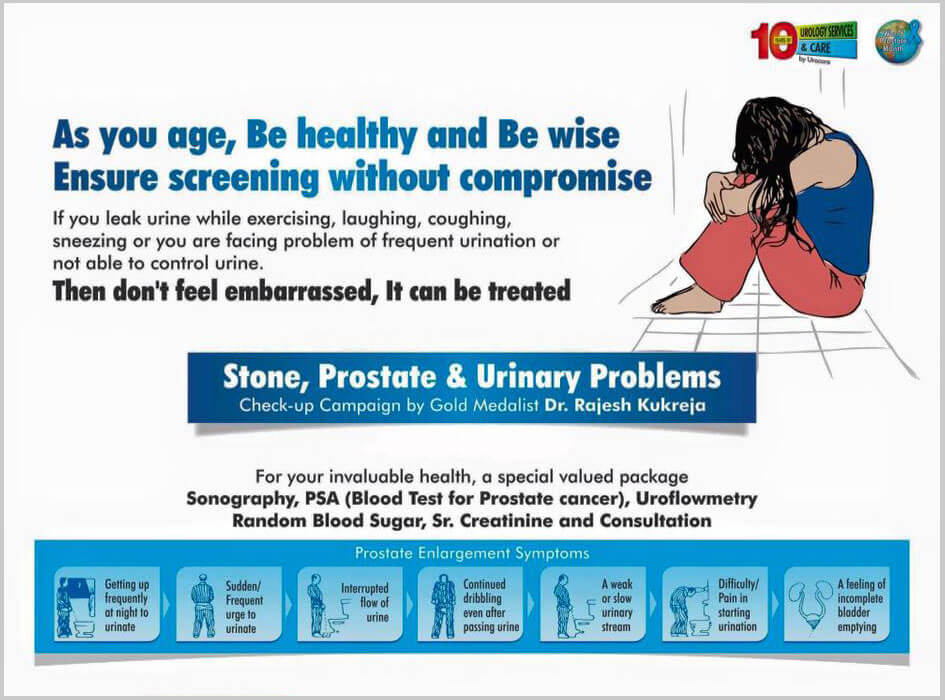Urinary Incontinence – Common In Females
The kidneys make urine continuously. A trickle of urine is constantly passing to the bladder down the ureters (the tubes from the kidneys to the bladder). You make different amounts of urine depending on how much you drink, eat and sweat.
The bladder is made of muscle and stores the urine. It expands like a balloon as it fills with urine. The outlet for urine (the urethra) is normally kept closed. This is helped by the pelvic floor muscles beneath the bladder that surround and support the urethra.
When a certain amount of urine is in the bladder, you become aware that the bladder is getting full. When you go to the toilet to pass urine, the bladder muscle squeezes (contracts) and the urethra and pelvic floor muscles relax to allow the urine to flow out.
Complex nerve messages are sent between the brain, the bladder and the pelvic floor muscles. These tell you how full your bladder is and tell the correct muscles to contract or relax at the right time.
Urinary incontinence is the unintentional passing of urine. It is a common problem and is thought to affect millions of people worldwide.
Urinary incontinence is common, especially in women. It can occur at any age but it is more likely to develop as you get older. As many as 1 in 5 women over the age of 40 have some degree of urinary incontinence.
It is likely that the true number of people affected is much higher. Many people do not tell their doctor about their incontinence, due to embarrassment. Some people wrongly think that incontinence is a normal part of ageing or that it cannot be treated.
This is unfortunate, as many cases can be successfully treated or significantly improved.
- Stress incontinence
is the most common type. It occurs when the pressure in the bladder becomes too great for the bladder outlet to withstand. This is usually caused by weak pelvic floor muscles.
Urine tends to leak most when you cough, laugh, sneeze or when you exercise (such as when you jump or run). In these situations there is a sudden extra pressure (stress) inside the tummy (abdomen) and on the bladder.
Small amounts of urine often leak. Sometimes much larger volumes of urine are accidentally passed. Pelvic floor muscles are often weakened by childbirth. Stress incontinence is common in women who have had several children,
in obese people and with increasing age. Stress incontinence can occur in men who have had surgical removal of the prostate (prostatectomy), and radiotherapy.
- Urge incontinence
(unstable or overactive bladder) is the second most common cause. You have an urgent desire to pass urine. Sometimes urine leaks before you have time to get to the toilet.
The bladder muscle contracts too early and the normal control is reduced. In most cases, the cause of urge incontinence is not known. This is called idiopathic urge incontinence. It seems that the bladder muscle gives wrong messages to the brain and the bladder may feel fuller than it actually is.
Sometimes urge incontinence can occur because of problems with the nervous system (the brain, spinal cord and other nerves in the body). Illnesses or diseases affecting the nervous system are called neurological disorders. Some people with certain neurological disorders may experience urge incontinence.
Examples are spinal cord diseases or injury, brain stroke, multiple sclerosis and parkinsonism.
- Mixed incontinence.
Some people have a combination of stress and urge incontinence.
- Overflow incontinence.
This occurs when there is an obstruction to the outflow of urine. The obstruction prevents the normal emptying of the bladder. A pool of urine constantly remains in the bladder that cannot empty properly.
This is called chronic urinary retention. Consequently, pressure builds up behind the obstruction.
- Bedwetting
(nocturnal enuresis) occurs in many children but some adults are affected.
Urinary incontinence can often be improved and can be cured in many cases. Urinary incontinence is treated differently according to the type and cause.
It is important to know which type of incontinence you have. Tell your doctor if you leak urine on a regular basis. You may also be asked to keep a diary for at least three days to assess:
- How often you go to the toilet.
- How much urine you pass each time.
- How often you leak urine.
What test are required to assess the cause and severity of the disease?
- Urinalysis. This is urine test to check for infection, sugar (glucose), blood or protein in urine.
Simple urinary infection (UTI) can also cause incontinence (leakage), particularly in older people.
Diabetes causes sugar in the urine and may cause increased thirst and an increased desire to urinate. Diabetes also puts you at more risk of UTI.
Diseases of the kidney may cause blood or protein in the the urine. Visible blood in the urine can be a sign of serious bladder problems or a UTI. - UIltrasound for assessing the kidneys, urinary bladder and Residual urine. This test finds out if any urine is left in your bladder and how much urine is left,
after you have gone to the toilet. The amount of urine is usually measured using an ultrasound scan which can look at your bladder and measure the amount of urine in it. - Vaginal and anal examination. A doctor or nurse may insert a gloved finger into the vagina and back passage (rectum). This can assess the strength and tone of the pelvic floor muscles. For men,
the rectal examination can also assess the size of the prostate gland. For women, the doctor or nurse may also look for signs of pelvic organ bulging (prolapse) during the vaginal examination. - Urodynamics. These are tests that assess the urine flow pattern and rate and the pressures generated in the urinary bladder during urine storage and voiding.
Treatment depends upon the type of urinary incontinence. Simple pelvic floor exercises may cure or improve stress incontinence.
Bladder training may help urge incontinence . Medications are sometimes used to help stop urge and stress incontinence.
Surgical options are less commonly required. Lifestyle changes may also significantly help some types of incontinence. These can include:
- Changing how much you drink. If you drink large volumes, it follows that you will pass more urine. If you suffer with incontinence,
you should not restrict your fluid intake too much, as you risk having a lack of body fluid (dehydration). Restricting fluids can also irritate the bladder and so make urge incontinence worse.
Drinking 6-8 glasses of water per day is recommended. In practical terms, it is best to drink when we need to, to quench our thirst. Remember that about one fifth of the water we take every day is hidden in food and that other drinks contain water. - Changing what you drink. Drinks containing caffeine (for example, tea, coffee, hot chocolate and cola) make urge incontinence worse. This is because caffeine is a natural diuretic.
Diuretics are chemicals that make you need to pass urine. If you drink a lot of caffeine-containing fluids then consider switching to decaffeinated alternatives. - Change when you drink. You should try to maintain a normal life as much as possible with regard to drinking and visiting the toilet. However, drinking late at night may mean your sleep is disturbed by the desire to get up and go to the toilet.
- Weight loss. It has been shown that losing a modest amount of weight can improve urinary incontinence in overweight and obese women. Even just 5-10% weight loss can help symptoms.
If you are overweight and incontinent then you should first try to lose weight in conjunction with any other treatments. - Toilet habit. Depending on how much (and what) you are drinking and your level of activity (how much you are sweating), it is normal to pass urine every 3-4 hours on average.
- Avoiding constipation Try to maintain a healthy balanced diet that contains plenty of fruit, vegetables and soluble fibre. Severe long-term (chronic) constipation can stop the bladder emptying properly and cause overflow urinary incontinence. Dehydration can also cause constipation.
Pelvic Floor Muscles Exercise
The pelvic floor muscles are located between your legs, and stretch like a hammock from your pubicbone at the front to the base of your spine at the back.
They are shaped like a sling and hold your pelvic organs (uterus, vagina, bowel and bladder) in place. The pelvic floor muscles support the bladder and bowel, and give you control when you urinate.
They relax at the same time as the bladder contracts (tightens) to let urine out. The pelvic floor has several functions:
- it supports your pelvic and abdominal organs, especially when you are standingor straining;
- it helps the opening of the bladder to stay closed when you cough, sneeze or strain;
- it is used to control leakage of wind or motions from your lower bowel;
- it helps to increase sexual awareness by tightening during intercourse.
Keeping pelvic floor muscles strong The pelvic floor can become weak because of:
- childbirth,
- prolonged straining to empty your bowels,
- lack of exercise and
- menopause.
- It may, of course, simply deteriorate as a result of ageing.
- A weak pelvic floor gives you less control so that you leak urine when you exercise, cough, lift or sneeze.
- A weak pelvic floor gives you less control so that you leak urine when you exercise, cough, lift or sneeze.
- There is also a risk of pelvic organ prolapse, where one or more of the pelvic organs bulges into the vagina.
Doing pelvic floor exercises can help to improve stress incontinence by keeping your pelvic muscles strong. Both men and women can do pelvic floor exercises.
You can feel your pelvic floor muscles if you try to stop the flow of urine when you go to the toilet. However, it is not recommended that you regularly stop your flow of urine midstream, because it can be harmful to the bladder.
Try to tighten the muscles around your back passage and vagina, lifting up inside as if you are trying to stop passing wind and urine at the same time. Try to avoid tensing your abdomen, squeezing your legs together, tightening your buttocks or holding your breath. If you can master this, most of the muscle contraction should be coming from the pelvic floor
To strengthen your pelvic floor muscles, sit comfortably and squeeze the muscles 10 to 15 times in a row. Do not hold your breath or tighten your stomach, buttock or thigh muscles at the same time.
You need to develop two type of muscle activity, slow and fast.
To practice slow contractions, do the exercises above and try to hold the pelvic floor tight for up to ten seconds. Rest for four seconds and then repeat the contraction as many times as you can up to a maximum on ten contractions.
To practice quick contractions, which will protect you against leakage during coughing, laughing or exercise, draw the pelvic floor rapidly upwards and hold this for one second. Repeat up to a maximum of ten times.
Aim to do one set of slow contractions followed by one set of fast contractions six times a day.
When you get used to doing pelvic floor exercises, you can try holding each squeeze for a few seconds. Every week, you can add more squeezes, but be careful not to overdo it and always have a rest between sets of squeezes.
After a few months, you should start to notice the results. Your incontinence should improve, as well as the sensitivity you experience during sex. You should carry on doing the exercises, even when you notice them starting to work.

